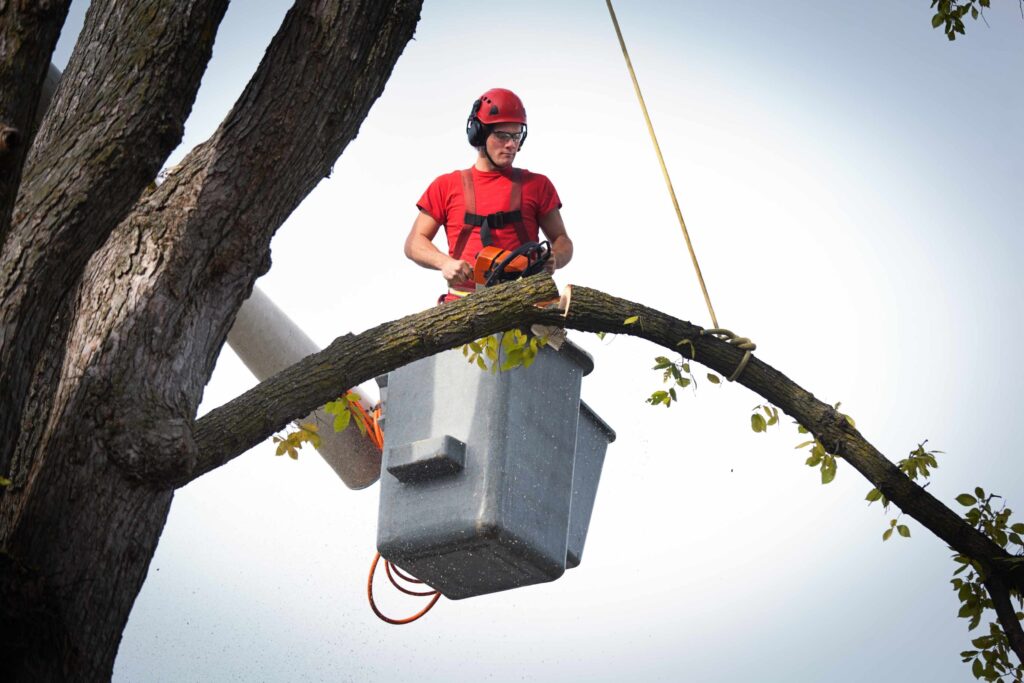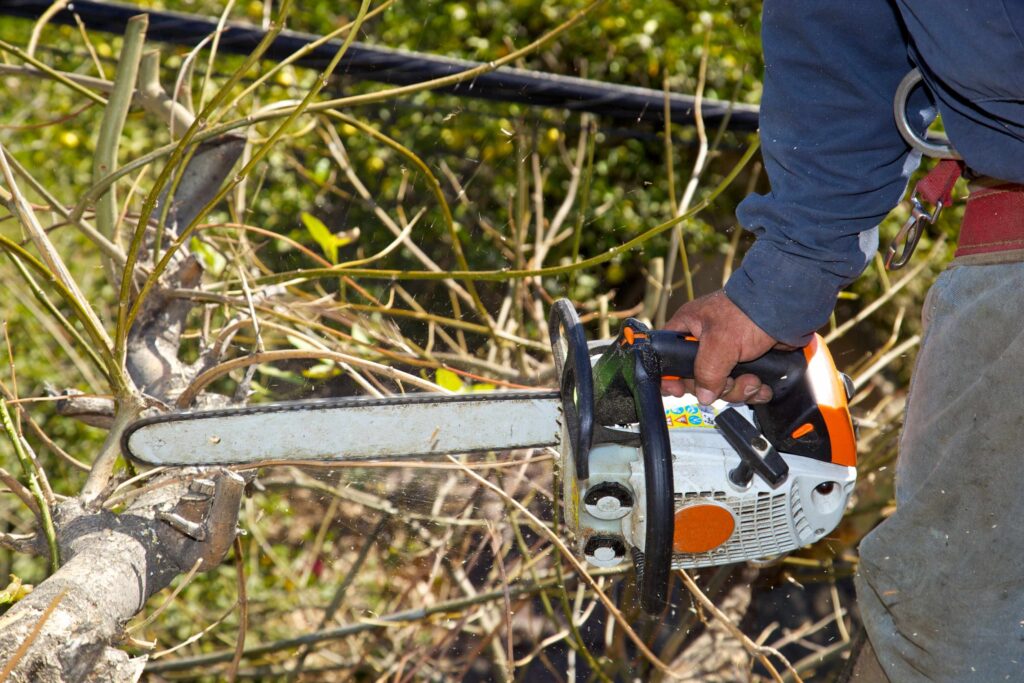Palm tree pruning is an essential aspect of maintaining the health and appearance of these iconic tropical trees. Whether you have a few palm trees in your backyard or work in a professional landscaping company, understanding the special considerations and care required for palm tree pruning is crucial.
In this article, we will explore the anatomy of palm trees, the importance of pruning, when to prune, the tools and equipment needed, and a step-by-step guide to effective palm tree pruning.
Understanding Palm Tree Anatomy
Before we delve into the pruning techniques, it’s important to familiarize ourselves with the anatomy of a palm tree. Palm trees have a unique structure, consisting of a trunk, fronds, and a canopy. The trunk is comprised of a single stem, which may be smooth or covered in fibrous material. The fronds, or leaves, are arranged in a spiral pattern at the top of the trunk. These fronds play a vital role in the tree’s photosynthesis and overall health. Lastly, the canopy refers to the collective mass of fronds that form a distinctive crown at the top of the palm tree.
Understanding the anatomy of a palm tree goes beyond just the visible parts. Beneath the surface, palm trees have a complex root system that helps anchor them in the soil and absorb nutrients and water. The roots of a palm tree are typically fibrous and shallow, spreading out horizontally from the base of the trunk. This unique root structure is adapted to the tree’s environment, allowing it to thrive in sandy or rocky soils.
Identifying Different Types of Palm Trees
There are numerous types of palm trees, each with its own unique characteristics. Some common palm tree varieties include Date palms, Coconut palms, and Queen palms. It is important to know the specific type of palm tree you are working with, as different varieties may have differing pruning needs.
Key Features of a Palm Tree
In addition to understanding the different types of palm trees, it is crucial to be aware of the key features of a palm tree. These features include the trunk, fronds, canopy, and root system. Proper pruning techniques take into account these unique features to ensure optimal tree health and growth.
When identifying a palm tree, it’s essential to consider not only its above-ground characteristics but also its growth habits and environmental requirements. Some palm trees are more suited to tropical climates, while others can thrive in arid or subtropical regions. By understanding the key features of a palm tree, you can better care for and maintain these iconic trees in various landscapes.
The Importance of Pruning Palm Trees
Pruning palm trees is not just about aesthetics; it plays a crucial role in the overall health and longevity of the tree. Regular pruning allows for the removal of dead or diseased fronds, promotes better air circulation, reduces the risk of pest infestations, and supports the tree’s natural growth patterns. By investing time and effort into palm tree pruning, you are actively contributing to the tree’s overall well-being.

Enhancing Tree Health
One of the primary reasons for pruning palm trees is to enhance their health. Removing dead or dying fronds helps prevent the spread of diseases and provides more resources for the healthy parts of the tree. Additionally, pruning promotes the growth of stronger and more resilient fronds, contributing to the overall vitality of the palm tree.
Preventing Disease and Pest Infestations
Palm trees are susceptible to various diseases and pest infestations. Pruning is an effective preventative measure, as it allows for the early detection and removal of infected or infested fronds. By eliminating these sources of disease and pests, you can protect your palm tree from further harm and ensure its long-term health.
Furthermore, proper pruning techniques can also help shape the palm tree’s canopy, creating a more visually appealing and balanced appearance. By selectively removing certain fronds, you can achieve a symmetrical and well-proportioned canopy that enhances the overall landscape aesthetic. This attention to detail not only benefits the tree but also adds value to your property, making it more attractive and inviting.
Environmental Benefits
In addition to the direct impact on the palm tree itself, pruning also offers environmental benefits. By maintaining a healthy and well-pruned palm tree, you are contributing to a more sustainable ecosystem. Improved air circulation within the tree helps filter pollutants and enhances oxygen production, creating a healthier environment for both humans and wildlife. Furthermore, proper pruning practices reduce the risk of fronds breaking off during storms, minimizing potential safety hazards and property damage.
When to Prune Your Palm Tree
Knowing when to prune your palm tree is crucial to ensure optimal results. While palm trees can be pruned throughout the year, it is essential to consider seasonal factors and signs that indicate the need for pruning.

Pruning your palm tree not only enhances its aesthetic appeal but also promotes overall health and growth. By removing dead or damaged fronds, you allow the tree to allocate more energy to new growth, resulting in a healthier and more vibrant palm tree.
- Mice Removal Sydney: Stop Night-Time Scurrying for Good
- Rodent Removal Sydney: Why Going Professional Beats DIY Every Time
- Best Hampers Sydney: Treat Your Loved Ones This Easter
- Easter Gift Hampers Delivered to Melbourne for a Memorable Holiday
- Tree Pruning Services Near Me: Finding Local Experts
Seasonal Considerations for Pruning
In general, the best time to prune palm trees is during late winter or early spring. Pruning during this period allows the tree to recover and regenerate before the onset of new growth in the warmer months. However, it is important to note that not all palm tree species follow the same pruning schedule. Some varieties may require pruning during different seasons to ensure proper growth and development. Researching the specific needs of your palm tree species will help you determine the most suitable pruning time.
During the pruning process, it is essential to use clean and sharp tools to prevent tearing or damaging the palm tree’s fronds. Proper pruning techniques, such as cutting at a slight angle to allow water runoff and avoiding cutting too close to the trunk, can help minimize stress on the tree and promote faster healing.
Signs Your Palm Tree Needs Pruning
Aside from considering seasonal factors, there are certain signs that indicate your palm tree needs pruning. These signs include dead or brown fronds, crossed or rubbing fronds, and excessive thatch or debris accumulation in the canopy. Regularly inspecting your palm tree and identifying these signs will help you determine when it’s time to prune and maintain its health.
When pruning your palm tree, it is crucial to prioritize safety by wearing appropriate protective gear, such as gloves and safety glasses, to prevent injuries from sharp fronds or falling debris. Additionally, consulting with a professional arborist for complex pruning tasks or large palm trees can ensure proper care and maintenance for your tree’s longevity.
Tools and Equipment for Palm Tree Pruning
Now that we understand the importance of palm tree pruning and when to do it, let’s explore the tools and equipment necessary for the job.
When it comes to palm tree pruning, having the right tools and equipment can make all the difference in achieving a successful outcome. Proper pruning not only enhances the tree’s appearance but also promotes its overall health and growth. Let’s delve deeper into the world of palm tree pruning tools to understand their significance in maintaining these majestic trees. You can also read about Exploring the Role of Flowers in Global Wedding Traditions by visiting https://bloomengine.net/exploring-the-role-of-flowers-in-global-wedding-traditions/
Safety Gear for Pruning
Prior to beginning any pruning task, it is crucial to prioritize safety. Essential safety gear for palm tree pruning includes gloves, eye protection, and sturdy footwear. Gloves protect your hands from potential injuries caused by thorns or rough surfaces, while eye protection ensures your eyes are shielded from falling debris. Sturdy footwear provides stability and prevents accidents while working at heights.
Additionally, wearing a helmet can offer extra protection, especially when dealing with taller palm trees where the risk of falling debris is higher. Ensuring that all safety gear fits properly and is in good condition is paramount before embarking on any pruning project.
Choosing the Right Pruning Tools
Choosing the right pruning tools for palm tree pruning is essential to ensure effective and efficient results. Some commonly used pruning tools include hand pruners, loppers, and pole saws. Hand pruners are suitable for smaller fronds and branches, while loppers and pole saws are ideal for larger or hard-to-reach areas. Prioritize quality when purchasing these tools to ensure longevity and ease of use.
For palm trees with hard-to-reach fronds at the top, consider investing in a sturdy ladder or even a specialized tree-climbing harness. These tools can provide safe access to high branches, allowing for thorough pruning without compromising safety. Remember, using the right tools not only makes the job easier but also ensures that the palm tree is pruned correctly, promoting its health and vitality in the long run.
Step-by-Step Guide to Pruning Palm Trees
Now that we have the necessary knowledge and tools, let’s dive into a step-by-step guide to pruning palm trees.
Preparing Your Tree for Pruning
The first step in palm tree pruning is to prepare the tree for the task. Start by removing any debris or thatch from the canopy using a leaf rake or broom. This step ensures better visibility and accessibility during the pruning process. Additionally, inspect the tree for any signs of pests or diseases and make note of areas that require attention.
Take a moment to appreciate the unique beauty of your palm tree. These majestic trees have been around for millions of years, with their distinctive fronds swaying gracefully in the breeze. As you prepare to prune, remember that you are not just shaping the tree’s appearance, but also contributing to its overall health and longevity.

Techniques for Effective Pruning
When it comes to pruning palm trees, there are several techniques to achieve the best results. Begin by removing any dead or dying fronds, making clean cuts as close to the trunk as possible. Avoid cutting into the trunk or removing healthy green fronds, as this can harm the tree. Be cautious of working near power lines or structures and use proper safety measures when using ladders or climbing equipment. Regularly stepping back to assess the tree’s overall appearance will help ensure a balanced and aesthetically pleasing result.
As you carefully prune each frond, imagine the tree’s resilience and ability to adapt to its environment. Palm trees have evolved to withstand harsh conditions, from strong winds to droughts, and by pruning with care, you are helping the tree maintain its strength and vitality.
Remember, pruning is not just an aesthetic task, but also a way to promote the tree’s health. By removing dead or diseased fronds, you are preventing the spread of potential infections and allowing the tree to allocate its resources more efficiently.
By following these step-by-step instructions and paying attention to the unique needs of your palm tree, you can effectively prune and care for your palm tree. Regular pruning will not only enhance the tree’s appearance but also contribute to its health and longevity. Remember to stay safe, use the appropriate tools, and consult with a professional if needed. With the right knowledge and care, your palm tree will continue to thrive for years to come.
